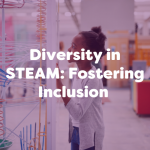Early childhood is a critical time for shaping a young person’s beliefs, attitudes and values. Therefore, early years settings play a crucial role in promoting equality and diversity among young children. These settings can provide children with a safe and supportive environment to be themselves and feel accepted and teach others to be accepting and kind to everyone, regardless of their background. In this blog, we will cover 5 ways in which you can promote diversity and equality in an early years setting.

1. Create an inclusive environment
An inclusive environment is the first step in promoting diversity and equality. An inclusive environment refers to a space that celebrates diversity, values individuality and promotes respect for others. To facilitate this, consider the following:
- Provide a wide range of resources and materials for example if you have dolls in your setting, are they in a range of skin tones and reflect different ethnicities or characteristics?
- Ensure your displays or anything visible in your setting also reflects a range of different people from different backgrounds to make this as representative of the real world as possible
- Are your books accessible and do they offer children a way in which to learn about people from different cultures or people with different backgrounds, abilities and families?
- Are you using inclusive language? This needs to be considered for written language such as words displayed in pictures on the wall and also verbal communication. Consider gender-neutral language and avoid making assumptions about identities or backgrounds.

2. Provide diversity training for your staff
Training for staff members is essential to help them to understand different perspectives, cultures and individuals. Training could include teaching about language barriers, supporting children with Special Education Needs or disabilities (SEN/D) or just generally about cultural differences.
Ongoing training in these areas will ensure staff are up to date with the latest practices and will therefore be able to create a welcoming and respectful environment for all. It might also be beneficial to consider developing policies and procedures for your setting that lay out appropriate practice in clearer terms for the staff or specify how frequently professional development should be taking place

3. Incorporate inclusive teaching strategies
Building upon the previous consideration, it is also important for settings to adopt inclusive practices that cater to the diverse needs of the children in your care. To do this, why not consider the following:
- Do your teaching strategies or activities engage all the children in your care? Do they accommodate different learning styles and abilities?
- Have you considered additional aids such as visual aids or a sensory area for children who prefer hands-on learning for example?
- Do you work closely with parents or specialists to ensure specific needs are met?
- Do children have the opportunity to express themselves and share their own experiences?
Such inclusive teaching strategies can be effectively used to again promote respect for diversity and encourage acceptance of others
4. Celebrate diversity and differences
A fundamental aspect when it comes to promoting diversity and equality is embracing and celebrating differences. This can be by celebrating different cultural festivals, sharing traditions or even comparing family structures. This will work to promote a positive message about diversity and inclusivity and will allow children to experience more elements of the diverse world around them.

5. Support children with different needs
One final consideration for early years’ settings is to support children with additional needs, including children with SEN/D. Ensuring that you are providing equal support to children with different needs will allow all children to participate and will further foster a sense of equality and diversity in your setting.
Early promotion of diversity and equality encourages children to be accepting from an early age and exposes them to a truer representation of the world around them
Using inclusive language, designing your setting to be as inclusive as possible and making sure to celebrate all similarities and differences between people are just some of the ways in which you can promote diversity in the early years of a child’s life
The EYFS guidance offered by Birth to 5 Matters highlights that inclusion and equality apply to all children and their families. More specifically, racial and cultural differences should be recognised, discussed and valued.
The EYFS framework promotes equality by requiring there to be regular assessments of all children’s needs, ensuring that settings are providing an inclusive environment and promoting diversity
Diversity in the EYFS is referred to as differences in age, culture, family structures, disabilities, ethnicities, gender, religion and sexual orientation.
Having an inclusive environment supports the social and emotional development of children. Students feel valued, happier and are prepared with social skills that will help them in the real world.




